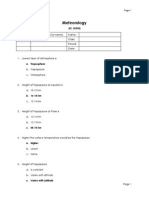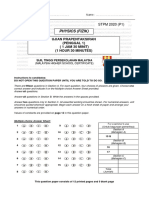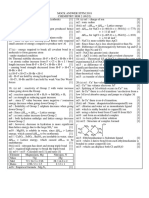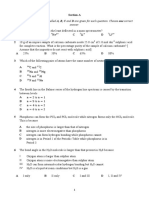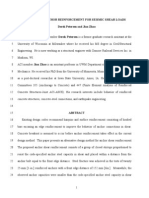0 ratings0% found this document useful (0 votes)
1K viewsSTPM 2014 Sem 1 Real
STPM 2014 Sem 1 Real
Uploaded by
evacuate clash1) Ammonia has weak intermolecular forces between its polar molecules, giving it a low boiling point despite its large molecular size.
2) The electronic configuration of nitrogen is 1s22s22p3, with the 2p orbitals each filled with a single electron of parallel spin according to Hund's rule.
3) The reaction of 4-hexene is second order with respect to 4-hexene concentration. The rate constant was determined to be 0.040 mol-1dm3s-1 from the slope of a plot of 1/[4-hexene] versus time.
Copyright:
© All Rights Reserved
Available Formats
Download as PDF, TXT or read online from Scribd
STPM 2014 Sem 1 Real
STPM 2014 Sem 1 Real
Uploaded by
evacuate clash0 ratings0% found this document useful (0 votes)
1K views2 pages1) Ammonia has weak intermolecular forces between its polar molecules, giving it a low boiling point despite its large molecular size.
2) The electronic configuration of nitrogen is 1s22s22p3, with the 2p orbitals each filled with a single electron of parallel spin according to Hund's rule.
3) The reaction of 4-hexene is second order with respect to 4-hexene concentration. The rate constant was determined to be 0.040 mol-1dm3s-1 from the slope of a plot of 1/[4-hexene] versus time.
Original Description:
Tt
Original Title
Stpm 2014 Sem 1 Real
Copyright
© © All Rights Reserved
Available Formats
PDF, TXT or read online from Scribd
Share this document
Did you find this document useful?
Is this content inappropriate?
1) Ammonia has weak intermolecular forces between its polar molecules, giving it a low boiling point despite its large molecular size.
2) The electronic configuration of nitrogen is 1s22s22p3, with the 2p orbitals each filled with a single electron of parallel spin according to Hund's rule.
3) The reaction of 4-hexene is second order with respect to 4-hexene concentration. The rate constant was determined to be 0.040 mol-1dm3s-1 from the slope of a plot of 1/[4-hexene] versus time.
Copyright:
© All Rights Reserved
Available Formats
Download as PDF, TXT or read online from Scribd
Download as pdf or txt
0 ratings0% found this document useful (0 votes)
1K views2 pagesSTPM 2014 Sem 1 Real
STPM 2014 Sem 1 Real
Uploaded by
evacuate clash1) Ammonia has weak intermolecular forces between its polar molecules, giving it a low boiling point despite its large molecular size.
2) The electronic configuration of nitrogen is 1s22s22p3, with the 2p orbitals each filled with a single electron of parallel spin according to Hund's rule.
3) The reaction of 4-hexene is second order with respect to 4-hexene concentration. The rate constant was determined to be 0.040 mol-1dm3s-1 from the slope of a plot of 1/[4-hexene] versus time.
Copyright:
© All Rights Reserved
Available Formats
Download as PDF, TXT or read online from Scribd
Download as pdf or txt
You are on page 1of 2
MARKING SCHEME
STPM SEMESTER 1 2013 / 14 962 / 1 (CHEMISTRY)
Section B and C
16 a) - Ammonia has attraction forces / polar molecules / hydrogen b) i. m1 : - Hund's rule : orbitals with the same energy levels are
bond / weak Van Der Waals forces / intermolecular forces [1] each filled with 1e- singly / parallel spins @ degenerate orbitals
- particle has volume / large molecular size / occupied space [1] with maximum number of parallel e- are more stable [1]
b) - low pressure ; high temperature [1] m2 : - electronic configuration X = 1s22s22p3 @ diagram [1]
c) - PV = nRT @ PV = mRT / MR [1] - 2px , 2py , 2pz must be filled with single e-/ parallel spin [1]
PM R m MR [1] ii. m1 : 2s [1] 2py 2pz 2px
ρ= / ρ= y y
m2 : shape [1]
RT V RT m3 : label 2px [1]
d) Total MR = 17.0 + 4.0 + 28.0 = 49.0 [1] x x
(1.01 × 105 )(49.0) [1] z z
ρ= (ins 49.0)
(8.31)(30 + 273)
In g dm-3 ; p = 1.97 g dm-3 (3 s.f.) [1] 19 a) i. m1 : - Electron pair repulse as far apart as possible. [1]
m2 : - lone-pair & lone-pair repulsion > lone-pair & bond-pair
17 a) Calculate 1/ [C4H6] and place in graph accordingly [1] repulsion > bond-pair & bond-pair repulsion [1]
Time / s 0 1000 1800 3000 4000 ii. Alt : (If CF2I+ ; m1 - 3 b.p.e ; m2 : trigonal planar ; m3 : 1200)
[C4H6] / 10-3 ClF2+ SF4
13.3 8.54 6.67 5.00 4.17
mol dm-3 Structure @
1/ [C4H6] / description [1] [1]
75.2 117 150 200 240
mol-1 dm3
Bond pair m1 : 2 b.p.e- / 1 l.p.e- m4 : 4 b.p.e- / 1 l.p.e-
b) Axis [1] (with unit) ; plotting points [1] ; linear plot [1] & Lone pair m2 : bent [1] m5 : see-saw [1]
300 Angle m3 : 104.5 ≤ x < 109.5 m6 : y < 1800
b) i. m1 : - MgCl2 has ionic bond / fix position / no mobile e- [1]
1/[C4H6] / mol-1 dm 3
250 m2 : - molten MgCl2 contain free mobile ions [1]
200 m3 : - Cu can delocalise e- in solid and molten state [1]
ii. m1 : - Ice has open lattice structure @ diagram contain 5 H2O [1]
150 m2 : - Ice occupied larger volume than water (or reverse) [1]
100 m3 : - when ice melt, the hydrogen bond broken [1]
m4 : - hence water molecule become closer / distance smaller [1]
50
0 20. a) * For m3 : KC is inverse of KC'
[ AB]2 [ A ][ B ] 1
0 1000 2000 3000 4000 5000 m1 : K C = [1] m 2 : K 'C = 2 22 [1] m3 : K C = ' [1]
[ A 2 ][ B 2 ] [AB] Kc
time / s b) A + 2B ↔ 2C
Initial 1.0 / 2.0 1.5 / 2.0 0
c) i. second order [1] Changes - 0.35 / 2 - 0.35 + 0.35
ii. gradient = rate constant (ins gradient / k ) 0.5 - x @ 0.75 - 2x @ 0 + 2x
240 − 200 At eq. m1 : 0.325 [1] m2 : 0.40 [1] 0.35
k= [1] ; k = 0.040 mol −1dm 3s −1 [1]
4000 − 3000 [C]2 (0.35) 2
m3 : K C = [1] m4 : K C = [1]
iii. rate equation ; rate = k [C4H6]2 (follow through i. order) [1] [ A][B]2 (0.325)(0.40) 2
m5 : Kc = 2.4 mol-1 dm3 [1]
18. a) Energy (m1)
n=∞ b) ii. Using Van't Hoff equation [1]
n= 5 m1 : ∆H 1
ln K = +C
n= 4 R T1
m2 : K 2 ∆H 1 1 [1]
n= 3 ln = −
K1 R T1 T2
n= 2 m3 : K 2 − 20000 1 1 [1]
ln = −
2.4 8.31 1000 1300
n= 1 m4 : K2 = 1.4 mol-1 dm3 (accept : 1 mol-1 dm3) [1]
Lyman Series (m2) Balmer Series (m3)
* Show at least 1 electron transfer) iii. m1 : - Since forward reaction is exothermic,
m4 : energy level converge (become closer) m2 : - equilibrium shift to left [1]
ii. m1 : f = 3.00 x 108 / 121.6 x 10-9 [1] m2 : 2.47 x 1015 s-1 [1] m3 : - [C] decrease [1]
m3 : f = c / λ or ∆E = hf [1]
m4 : ∆E = 6.63 x 10-34 x 2.47 x 1015 s [1]
m5 : E = 1.64 x 10-18 J [1]
Alternative : ∆E = hf @ h c / λ [m1 + m2] (if only E = hf [m2])
(6.63 × 10 −34 ) (3.00 × 108 ) [ m3] m5 : E = 1.64 x 10-18 J [1]
∆E =
121.6 × 10 −9 [m 4]
You might also like
- IC Joshi Aviation Met Total Q.Document94 pagesIC Joshi Aviation Met Total Q.Gaurav Sawaai100% (6)
- Experiment 3Document5 pagesExperiment 3Ji Sian LeeNo ratings yet
- STPM Maths T 2020 Assignment Conclusion ExampleDocument1 pageSTPM Maths T 2020 Assignment Conclusion ExampleLing YiNo ratings yet
- Limits and Continuity: Focus On STPM 7Document6 pagesLimits and Continuity: Focus On STPM 7Wei Chuan TanNo ratings yet
- STPM Chemistry Term 1 Topic 6A Chemical EquilibriumDocument23 pagesSTPM Chemistry Term 1 Topic 6A Chemical EquilibriumChris Lau100% (7)
- BF02692337 PDFDocument2 pagesBF02692337 PDFHitesh LokeNo ratings yet
- Ufo CFDDocument58 pagesUfo CFDböhmitNo ratings yet
- STPM 2016 Sem 1 Real MsDocument2 pagesSTPM 2016 Sem 1 Real Mssliong1020No ratings yet
- STPM 2018 Sem 1 Mock AnsDocument2 pagesSTPM 2018 Sem 1 Mock Ansm-7319562No ratings yet
- STPM 2023 SEM 2 Mock AnsDocument2 pagesSTPM 2023 SEM 2 Mock AnsHannah KaienNo ratings yet
- STPM 2020 Sem 1 Mock AnsDocument2 pagesSTPM 2020 Sem 1 Mock AnsNicole LimNo ratings yet
- STPM 2021 Sem 1 Mock AnsDocument3 pagesSTPM 2021 Sem 1 Mock Ansm-7319562No ratings yet
- L STPM 2019 SEM 1 MOCK ANSDocument2 pagesL STPM 2019 SEM 1 MOCK ANSm-7319562100% (1)
- STPM 2016 Physics 1Document16 pagesSTPM 2016 Physics 1Abdul ShariffNo ratings yet
- STPM2023 S1 ChemistryDocument20 pagesSTPM2023 S1 ChemistrybilloveddNo ratings yet
- 2021 STPM 954-P1 AnsDocument5 pages2021 STPM 954-P1 AnsPavitraNo ratings yet
- STPM 2013 Sem 1Document7 pagesSTPM 2013 Sem 1nurulNo ratings yet
- STPM 2022 SEM 2 Mock AnsDocument2 pagesSTPM 2022 SEM 2 Mock Ansm-4306022No ratings yet
- 06AAMathT FWS Chapter 06Document21 pages06AAMathT FWS Chapter 06Selina WongNo ratings yet
- Real Marking Scheme For STPM 2016 962 / 2: Chemistry Paper 2Document2 pagesReal Marking Scheme For STPM 2016 962 / 2: Chemistry Paper 2PAVITRA A/P THEVINDRAN MoeNo ratings yet
- 962 Chemistry (PPU - STPM) Semester 3 Topics-SyllabusDocument13 pages962 Chemistry (PPU - STPM) Semester 3 Topics-SyllabusJosh, LRTNo ratings yet
- Chem Sem 1 Percubaan SMK Pusat Bandar PuchongDocument12 pagesChem Sem 1 Percubaan SMK Pusat Bandar Puchongevacuate clashNo ratings yet
- STPM 2022 Sem 3 Mock AnsDocument2 pagesSTPM 2022 Sem 3 Mock Ansg-65251693100% (1)
- STPM 954 Math T Coursework 2012 (Sem 1)Document32 pagesSTPM 954 Math T Coursework 2012 (Sem 1)Josh, LRT100% (2)
- There Are Fifty Questions in This Paper. Answer All Questions. Marks Will Not Be Deducted For Wrong AnswersDocument16 pagesThere Are Fifty Questions in This Paper. Answer All Questions. Marks Will Not Be Deducted For Wrong AnswersSean100% (1)
- STPM Physics Experiment 8 Earth S Magnetic Field Second Term PDFDocument2 pagesSTPM Physics Experiment 8 Earth S Magnetic Field Second Term PDFVishalinie RamanNo ratings yet
- STPM 2009Document19 pagesSTPM 2009one kilometer100% (2)
- Physics STPM Sem 1 DefinitionDocument2 pagesPhysics STPM Sem 1 DefinitionBen40% (5)
- Project Report Chemistry (MAIN BODY)Document16 pagesProject Report Chemistry (MAIN BODY)Ung Hie HuongNo ratings yet
- Sem 1 2022 Manual ChemistryDocument9 pagesSem 1 2022 Manual ChemistryVZYFVVZHVMNo ratings yet
- Physics Sem 1 2020 TrialsDocument17 pagesPhysics Sem 1 2020 TrialsKeertana SubramaniamNo ratings yet
- Experiment 2 ProjectileDocument9 pagesExperiment 2 ProjectilevimalNo ratings yet
- STPM 2018 Sem 2 Mock AnsDocument2 pagesSTPM 2018 Sem 2 Mock Anstee hcNo ratings yet
- Experiment 5 ChemistryDocument3 pagesExperiment 5 ChemistryJack OngNo ratings yet
- Assignment Viva f6Document11 pagesAssignment Viva f6Magendren Raman50% (2)
- Mathematics (T) VIvaDocument11 pagesMathematics (T) VIvaJinJinKiraie0% (1)
- STPM Chemistry Form 6 Definition ListDocument16 pagesSTPM Chemistry Form 6 Definition ListCherry T CY100% (1)
- Lesson 41Document4 pagesLesson 41MarcTnn100% (1)
- STPM Maths T 2020 Assignment Methodology ExampleDocument3 pagesSTPM Maths T 2020 Assignment Methodology ExampleLing Yi0% (1)
- Manual Chemistry 2014Document83 pagesManual Chemistry 2014AlexTanYun-KaiNo ratings yet
- 2024 Sem 1 Trial MuarDocument14 pages2024 Sem 1 Trial MuarルーエデッドNo ratings yet
- STPM Baharu 2014 Sem 2 (Mathematics T 954)Document21 pagesSTPM Baharu 2014 Sem 2 (Mathematics T 954)Alex TanNo ratings yet
- Chemistry Pre-U Chemistry Sem 1 Chap 2Document48 pagesChemistry Pre-U Chemistry Sem 1 Chap 2Jia HuiNo ratings yet
- Maths T STPM 2014 Sem 1 P1 Trial Pahang AnswerDocument3 pagesMaths T STPM 2014 Sem 1 P1 Trial Pahang AnswerKenneth ChanNo ratings yet
- STPM 2021 Sem 3 Mock AnsDocument2 pagesSTPM 2021 Sem 3 Mock AnsNATASHA NADIA BINTI ABDULLAH MoeNo ratings yet
- Answer Scheme Chemistry P1 2022 Set 1Document6 pagesAnswer Scheme Chemistry P1 2022 Set 1Tan JennyNo ratings yet
- Experiment 3-Volumetric Analysis - Purity and Stoichiometry Hanif MenhadDocument8 pagesExperiment 3-Volumetric Analysis - Purity and Stoichiometry Hanif MenhadFoo Chee HengNo ratings yet
- STPM 2014 Sem 2 Real AnsDocument1 pageSTPM 2014 Sem 2 Real AnsXue Yi LamNo ratings yet
- PROPOSAL FOR CHEMISTRY PROJECT STPM 2023 New-1Document6 pagesPROPOSAL FOR CHEMISTRY PROJECT STPM 2023 New-1Thurgahini KikaNo ratings yet
- STPM Sem 1 Introductory Class Notes 2020 Part 2 PDFDocument5 pagesSTPM Sem 1 Introductory Class Notes 2020 Part 2 PDFJohnson116No ratings yet
- STPM Physics Chapter 15 Direct Current CircuitsDocument1 pageSTPM Physics Chapter 15 Direct Current CircuitsChris Lau100% (1)
- SEM 1 OVERALL (Summary)Document16 pagesSEM 1 OVERALL (Summary)Peh ZeroxNo ratings yet
- STPM 2020 Sem 1Document9 pagesSTPM 2020 Sem 1fathin100% (1)
- SUGGESTED ANSWER STPM 2011 MATHEMATICS T Paper 2Document6 pagesSUGGESTED ANSWER STPM 2011 MATHEMATICS T Paper 2SKNo ratings yet
- Physics STPM Sem 2 FormulaeDocument2 pagesPhysics STPM Sem 2 FormulaeBen50% (8)
- Trial STPM Chemistry Sem 1 PDFDocument7 pagesTrial STPM Chemistry Sem 1 PDFsuhaidah47100% (1)
- Uppp2 2022 Sem 1 AnsDocument1 pageUppp2 2022 Sem 1 AnsyijieeNo ratings yet
- STPM 2025 SEM 1 MOCK ANSDocument2 pagesSTPM 2025 SEM 1 MOCK ANSTAN RU XIAN MoeNo ratings yet
- Physics Paper 2 SL MarkschemeDocument11 pagesPhysics Paper 2 SL MarkschemeAbdul RaqeebNo ratings yet
- All Koleksi Skema Pep Percubaan Pam2 2023Document2 pagesAll Koleksi Skema Pep Percubaan Pam2 2023Arif SaifullahNo ratings yet
- NEET PREP TESTDocument27 pagesNEET PREP TESTdeshmuksiddhiNo ratings yet
- Math Record1Document12 pagesMath Record1SABARISH SABARISHNo ratings yet
- Chem Sem 1 SMK Taman Johor Jaya AnsDocument2 pagesChem Sem 1 SMK Taman Johor Jaya Ansevacuate clashNo ratings yet
- The Signs of Sine, Cosine and Tangent of Any Angle: Tanda-Tanda Bagi Sinus, Kosinus Dan Tangen Bagi Sebarang SudutDocument1 pageThe Signs of Sine, Cosine and Tangent of Any Angle: Tanda-Tanda Bagi Sinus, Kosinus Dan Tangen Bagi Sebarang Sudutevacuate clashNo ratings yet
- pg308-311 ExtrasDocument5 pagespg308-311 Extrasevacuate clashNo ratings yet
- Chem Sem 1 Q &A PDFDocument9 pagesChem Sem 1 Q &A PDFevacuate clashNo ratings yet
- Chapter 3 - HOTS ExtraDocument3 pagesChapter 3 - HOTS Extraevacuate clashNo ratings yet
- Ozone DepletionDocument5 pagesOzone Depletionevacuate clash0% (1)
- New Doc 2019-07-31 23.03.44Document11 pagesNew Doc 2019-07-31 23.03.44evacuate clashNo ratings yet
- Detective Conan QuotesDocument1 pageDetective Conan Quotesevacuate clashNo ratings yet
- New Doc 2019-07-20 15.52.49Document1 pageNew Doc 2019-07-20 15.52.49evacuate clashNo ratings yet
- English Study MaterialsDocument5 pagesEnglish Study Materialsevacuate clashNo ratings yet
- Tiny Foods For Small Fry - EditedDocument5 pagesTiny Foods For Small Fry - Editedevacuate clashNo ratings yet
- The New ScientistDocument60 pagesThe New ScientistMedNo ratings yet
- Kwitansi Non Brin 19novDocument59 pagesKwitansi Non Brin 19novMuhammad RaffiNo ratings yet
- Mathematical Geophysics - c1Document17 pagesMathematical Geophysics - c1Amin KhalilNo ratings yet
- Engineering Mechanics-Static Friction Lecture-3 by Dr. Salah M. Swadi 2018-2019Document12 pagesEngineering Mechanics-Static Friction Lecture-3 by Dr. Salah M. Swadi 2018-2019Mona fabrigarNo ratings yet
- Ausgrid ESDR 2011Document298 pagesAusgrid ESDR 2011Andrew MitchellNo ratings yet
- Design of Anchor Reinforcement For Seismic Shear Loads-SubmissionDocument38 pagesDesign of Anchor Reinforcement For Seismic Shear Loads-SubmissionSarah Perez100% (1)
- Jumping and Hopping in Elite and Amateur Orienteering AthletesDocument7 pagesJumping and Hopping in Elite and Amateur Orienteering AthletesSavio SoaresNo ratings yet
- EmotionsIncludingAngerBodilySensationsand PDFDocument9 pagesEmotionsIncludingAngerBodilySensationsand PDFAlexander BukowskiNo ratings yet
- AverageDocument7 pagesAveragevighneshmanojNo ratings yet
- Belt and Rope Drives: Types of BeltsDocument10 pagesBelt and Rope Drives: Types of Beltsعبدالله باسم خلاوي مانعNo ratings yet
- Nuclear Medicine and Molecular Imaging The Requisites 5Th Edition Janis P Omalley Full Chapter PDFDocument69 pagesNuclear Medicine and Molecular Imaging The Requisites 5Th Edition Janis P Omalley Full Chapter PDFremarktrippl5100% (17)
- Damage Mechanics MatDocument210 pagesDamage Mechanics Matlekan4realNo ratings yet
- Effect of Settling Test Procedure On Sizing ThickenersDocument9 pagesEffect of Settling Test Procedure On Sizing Thickenersfaouzi rachidNo ratings yet
- Tuv Nel - Evaluation of Roxar MPFM2600 Multiphase Flowmeter PDFDocument23 pagesTuv Nel - Evaluation of Roxar MPFM2600 Multiphase Flowmeter PDFReza GhanavatiNo ratings yet
- Data 39 BusDocument16 pagesData 39 BusRajesh GangwarNo ratings yet
- Nuclear Physics TheoryDocument14 pagesNuclear Physics TheoryTanvir ShafalNo ratings yet
- Recommended ValueDocument2 pagesRecommended ValueShivpreet SharmaNo ratings yet
- Quality Characteristics of The Selected Variant of (Robust4) Wood Cultivated in HungaryDocument6 pagesQuality Characteristics of The Selected Variant of (Robust4) Wood Cultivated in HungaryVíctor Andrés Sepúlveda VillarroelNo ratings yet
- Electrocraft BLDC CatalogDocument49 pagesElectrocraft BLDC CatalogElectromateNo ratings yet
- A. Control Valves QuestionDocument2 pagesA. Control Valves QuestionAjay SatputeNo ratings yet
- Chapter 12 - Steel ProductsDocument40 pagesChapter 12 - Steel ProductsHeru Berian100% (1)
- CALA05 - Đào Nguyễn Nam - PS9Document10 pagesCALA05 - Đào Nguyễn Nam - PS9Nguyễn NamNo ratings yet
- Santosh Pokharel Et Al. Be Civil May 2023Document227 pagesSantosh Pokharel Et Al. Be Civil May 2023niharikasisa8No ratings yet
- Optical Coherence TomographyDocument27 pagesOptical Coherence TomographyGokulakrishnan KumarNo ratings yet
- TD MCQsDocument4 pagesTD MCQsgopichandallakaNo ratings yet
- Kelvin Water DropperDocument5 pagesKelvin Water Dropperericdundee9No ratings yet
